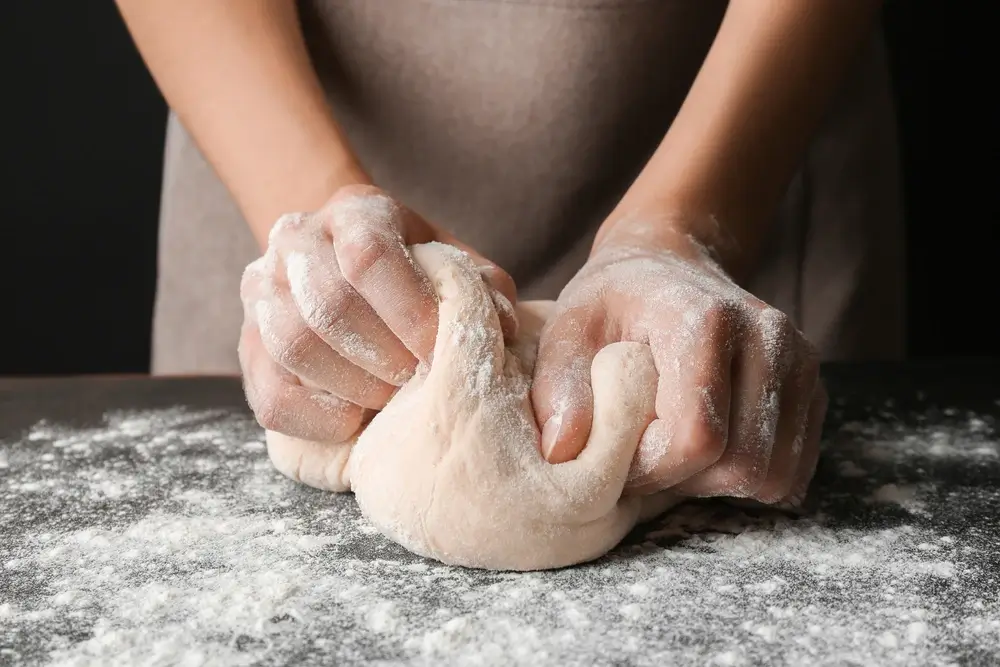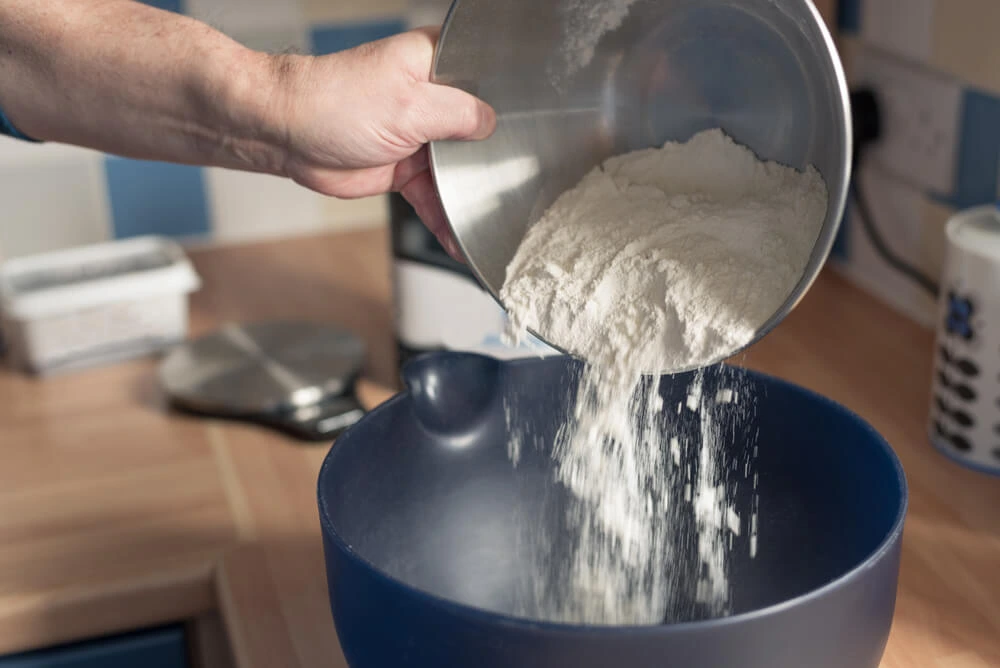
Are you in the mood to enjoy homemade pizza? Or are you making some pizza for your guest? But even after following every bit of a pizza recipe, is your pizza dough not rising?
It’s not a big problem. It can happen because of common pizza dough problems, such as if you use less yeast or old and dead yeast or if you don’t knead properly and don’t keep the dough at the right temperature. Many reasons can contribute to this flat dough situation.
But don’t worry! You can still fix it and make it work. Keep reading this article to find the reasons and solutions for your problem.
7 Top Reasons for Pizza Dough Not Rising
There are 7 most common reasons to make your pizza dough flat. Knowing these reasons will help you to avoid some common mistakes next time you make pizza.
1. Not Using Enough Yeast
Yeast is a leavening agent that makes your dough rise. But if you use an inadequate amount of yeast, your pizza dough is less likely to rise.
- If your proofing time is short, you will need to use more yeast to make your dough rise quickly. Add more yeast if you can’t allow your dough enough time to rise.
Note : Normally, you need to let your dough rest for 1-3 hours to get a good rise.
- If baking pizza in a cool region, you will need more yeast to make your pizza dough rise. However, you can use a smaller amount of yeast in warm temperatures.
2. Using Old Yeast
Before using any yeast, you should always check the expiration date of the yeast.
- Fresh yeast only has a two-week shelf life.
- Unopened dry yeast has a shelf life of 2 years which is pretty long. But the yeast will lose its potency over time if kept for that long: the older the yeast, the less likely dough to rise.
- New yeast or yeast only a few days old will make the dough rise best.
- It is also important how you store your yeast to retain its potency. Always store yeast away from direct heat and in a cold place for freshness.
3. Using Dead Yeast
Activating yeast with boiling water instead of lukewarm water is common mistake home bakers make. It kills the yeast. Remember that yeast are living fungi that will die if exposed to high temperatures.
However, you shouldn’t also use ice-cold water to activate your yeast. Because they won’t activate properly, your dough may not rise either.
Your dough will rise best if you use room temperature water, about 68℉ or lukewarm water, to activate your yeast.
4. Improper Kneading
If you don’t knead your dough properly, the chances are higher that you will end up with a flat dough. Kneading dough is considered an art, and for proper and thorough kneading, you should knead your dough for about 20 minutes.
- Kneading helps to structure the dough. If you don’t know, kneading allows the gluten protein in wheat flour to form a network of walls. The network keeps growing the more you knead. As a result, the dough gets shape and doesn’t collapse.
- Kneading doesn’t only structure the dough, but it also traps CO2 created as yeast feeds on sugars in the flour. Trapped CO2 gas expands the dough, causing it to rise. However, this gas escapes easily if the gluten network isn’t well established, resulting in a flat dough.
5. Temperature
You need to leave your dough at the right temperature to rise. The ideal temperature for making pizza dough rise is 73 to 75℉. So, if you leave your dough at a lower temperature, the yeast won’t activate, and your dough won’t rise.
That’s why never store your dough in the fridge or any cool place.
6. Using Too Much Salt
Salt is necessary for developing gluten proteins, which result in an elastic and smooth dough. However, too much salt kills the yeast. So, in the beginning, to prepare your dough, always add the required amount of salt to the flour.
Bonus : Antifungal ingredients such as cinnamon can kill the yeast. And some of the dried fruits contain antifungals as a preservative.
7. Using Too Large Container
It’s important to use the appropriate container to store dough. Whether you use a banneton, pan, or tray makes a difference. If you use a too-large container, the dough won’t rise as it won’t have anything to push against while rising. Instead, it will spread and, in the worst-case scenario, collapse.
It’s better to use a medium-sized bowl.
What to Do if Pizza Dough Doesn’t Rise?
Now you know that your pizza dough isn’t rising because of one of the three main reasons: improper kneading, problems with yeast, and the wrong temperature. Luckily you can solve this problem very easily and fix your pizza dough as if there were never a problem.
So, first, find out the cause and then take action.
1. Keep the Dough Container at a Warmer Place
Warmth and moisture are important for yeast to multiply and make the dough rise. Generally, it is enough to leave the dough at room temperature on the countertop to make it expand. But even after keeping the dough at room temperature, you will need to increase the temperature if it doesn’t rise.
- Boil some water and pour into a baking pan. Place the pan on the oven’s lowest rack and the dough container on the middle rack. Then shut the oven door and let the dough rise.
- Also, you can microwave a cup of water, then place the dough container in the microwave with the water and shut the microwave door. Just keep the dough there, don’t microwave it.
- Or, you can preheat the oven first. Then cover the dough with a damp towel and set it on top of the stove. The oven keeps the stovetop heated, and the damp towel adds moisture to the dough.
2. Add More Yeast
Even after placing your dough in a warm place, your dough is still flat. You will need to add more yeast to the dough to activate them.
- This time make sure to use new and fresh yeast. To activate the yeast, mix one teaspoon of yeast with 1 tablespoon of sugar and 1 cup of lukewarm or room temperature water. Let the mixture sit for 10 minutes or till the yeast creates a 1-inch layer of foam on top of the mixture. If this fails to do so, you will need to try again with new yeast.
- If the yeast activates, knead it into the dough to make it rise. This time knead the dough until it gets a firm and smooth consistency. And then, place the dough in a warm place again.
- However, you shouldn’t pour the yeast mixture as it is. Rather, combine flour and water, stir in the yeast, and mix with the flat dough.
3. Again Knead Your Dough, Properly

Kneading has to be done perfectly. If you under-knead the dough, the yeast won’t be distributed thoroughly, making the dough too weak to rise. On the other hand, if you over-knead the dough, it will become too tough to expand.
And on that, you need to follow the right kneading technique so that the dough traps enough CO2 gas to rise. Now you know why kneading is referred to as an art.
Ideally, it’s better to knead pizza dough for around 20 minutes to feel elastic and smooth.
4. Use More Flour
Add more flour while kneading if necessary. When you touch the dough, if it feels sticky, it is most likely that the dough is under-kneaded. So use more flour to knead until the dough is no longer sticky but silky and smooth to the touch.
Then allow the dough to rest and rise in a moist and warm place. Letting the dough sit overnight before you shape and bake it is even better.

FAQ
How Long Can Pizza Dough Sit Out?
Pizza dough shouldn’t sit out longer than 3 hours after it has risen. Keep the dough in the refrigerator if you don’t intend to roll it out immediately.
Why is My Pizza Dough Chewy?
If you use a lot of high-protein flour, gluten development in the dough will be overwhelming, making the dough excessively chewy once cooked and possibly inedible. That’s why it’s better to use all-purpose flour.
How Thin Should Pizza Dough Be?
If you want a thin, crisp crust, roll the dough out to about 1/4 inch thickness and pop it in the oven right away before it rises.
Wrap Up
I know nothing can be more disheartening than finding out your pizza dough isn’t rising, even though you have followed the recipe properly.
But don’t be too sad. Because most of the time, you can fix dough again, and almost all the major reasons causing flat dough can be avoided.
After reading this article, I hope you will never have to deal with flat pizza dough, or even if you have to deal with that, you will deal like a pro!

Monica Nash is the seniormost writer at www.limitlesscooking.com. She is excellent at designing the content, and she understands how the audience will receive each piece of work. And yes, she cooks very well! Her 3-year of experience and dedication make the whole team energized.
